Hiva Oa

VulcanSpirit
Richard & Alison Brunstrom
Tue 15 May 2012 04:11
|
French Polynesia covers an area of 4 million square
kilometres, the same size as Europe, but the land area is only 4000 square
kilometres and comprises 118 islands in five archipelagoes. We are in the
Marquesas, the northernmost group. These islands are volcanic, between 1-5
million years old (i.e. very recent) and have no fringing reefs - the water is
5000m deep just offshore. The Marquesas were first discovered by the Spanish in
the middle of the sixteenth century (they stayed a short while, killing about
200 locals, then left). The next European visitor was Captain Cook, more than
two hundred years later in the 1770s. The French annexed the islands in
1842.
When Europeans arrived the Polynesian population of
the Marquesas was about 100 000. Europeans introduced guns, alcohol and new
diseases, resulting in a 98% fall in the native population to about 2000.
Nowadays the islanders number about 8000, many of them of French
descent.
The islands are very rugged with high and very
steep hills. We're at Hiva Oa. Here is the anchorage. The hill in the background
(1300m) is permanently cloud covered at this time of year. I climbed very nearly
to the top of it yesterday in quite appalling weather on an amazingly steep
path. Real death defying stuff. I would never have believed that it was
possible to get a path up there if I hadn't walked it myself (no pictures due to
extreme bad weather):
 The southern side of the island is covered in dense
lush tropical vegetation:
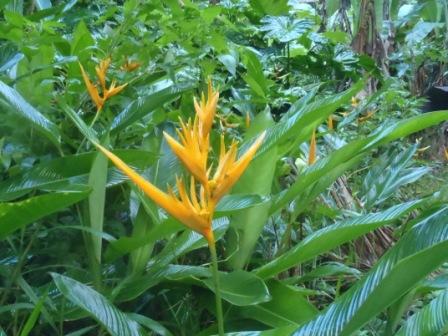 There are lots of fruits, mainly introduced but
flourishing. The grapefruit in particular are fabulous - about the size of a
decent melon and beautifully sweet. Hidden away in the forests are lots of
interesting prehistoric sites (the Marquesans arrived here about 2000 years ago,
but were still firmly in the Stone age when Europeans arrived); here is a rock
covered in petroglyphs. This one was a 3km walk up a very muddy track in the
jungle. You can just make out that some of them are stylised human figures - the
one above Ali's hand, for instance:
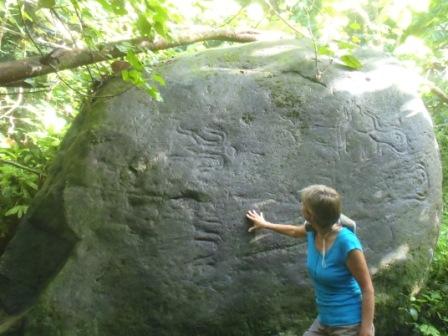 The northern side of the island is in the rain
shadow of the central ridge, and therefore much drier:
 This is Alison standing above one of the bays on
the north coast. The beaches are dark volcanic sand (no white sand here, because
no coral), and behind that is a coconut grove for the production of corpa which
is the main economic activity here.
Here is another north coast bay, this time at
Puamau (pronounced Pooh-ah-maw-oo). Polynesian languages have lots of vowels and
few consonants:
 We went here on a day tour to see the Tikis (stone
statues); the biggest ones in French Polynesia are at Paumau. Here is our guide
Mary-Jo. She was lovely; just as well because there wasn't another
English-speaking guide on the island. Most Polynesians, of both sexes, are big
people:
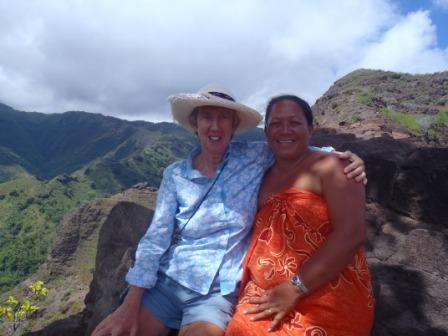 It's traditional in Polynesia for the ladies to
wear flowers in their hair. Here are Alison and our friend Sue trying to fit in
while bumping along a dirt track in the back of a Landrover (amazinly there
are loads of Landrovers here; the only ones you see in Central America and the
Caribbean are wrecks):
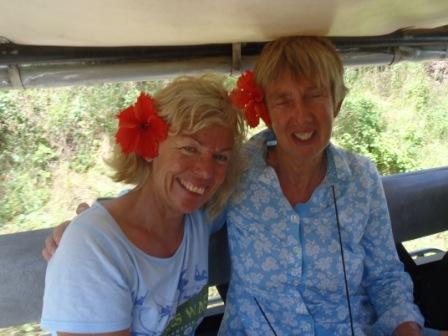 We have very few pictures of Alison with her eyes
open. I've started taking two pictures each time. I did on this occasion. She
has her eyes shut in both.
Tikis are representation of Polynesian gods. The
biggest one left at Puamau (typically, the best are in a museum in Berlin)
seen here on the right, is 2.3m high:
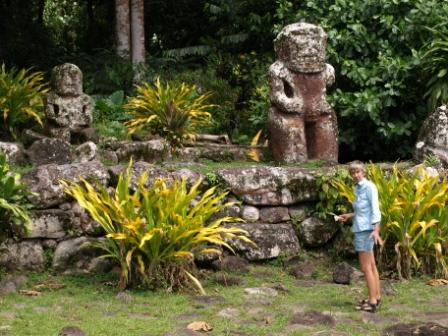 This is a temple complex whose history and purpose
are well recorded because the Polynesian tradition of oral history was still
functioning until fairly recently. These sites were used for all sorts of
rituals including human sacrifice (the Polynesians as a whole were a very
bloodthirsty and warlike lot, and the Marquesans were reknowned as amongst the
most violent). Cannibalism was still being practised here well into the
twentieth century.
Above and to the left of the tiki is a large
breadfruit tree:
 This is interesting because breadfruit is a native
of South America yet it was growing here when the Europeans first arrived. It is
proof that ancient Polynesians must have reached South America, nearly 4000
miles away, and brought it back. Here is a breadfruit; it's about the size
of a melon:
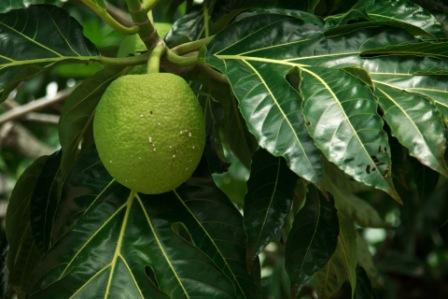 You can make all sorts of things from this,
including pretty good French Fries!.
That's it for Hiva Oa. We have packed the boat up
again ready for sea; tonight we leave for Fatu Hiva about 50 miles to the SE at
0400hrs (it's a ten hour sail, and we want to be sure to get there in the
daylight).
|